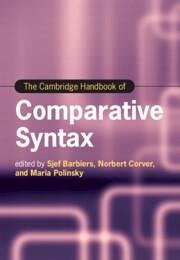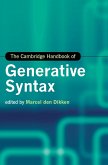The Cambridge Handbook of Comparative Syntax
Herausgeber: Barbiers, Sjef; Polinsky, Maria; Corver, Norbert
The Cambridge Handbook of Comparative Syntax
Herausgeber: Barbiers, Sjef; Polinsky, Maria; Corver, Norbert
- Gebundenes Buch
- Merkliste
- Auf die Merkliste
- Bewerten Bewerten
- Teilen
- Produkt teilen
- Produkterinnerung
- Produkterinnerung
"Bringing together a globally representative team of scholars, this book provides a comprehensive overview of the state-of-the-art in comparative syntax, the study of universal and variable properties of grammatical structures in natural languages. It is essential reading for researchers and students in linguistics"--
Andere Kunden interessierten sich auch für
![The Cambridge Handbook of Historical Orthography The Cambridge Handbook of Historical Orthography]() The Cambridge Handbook of Historical Orthography191,99 €
The Cambridge Handbook of Historical Orthography191,99 €![The Cambridge Handbook of Generative Syntax The Cambridge Handbook of Generative Syntax]() The Cambridge Handbook of Generative Syntax189,99 €
The Cambridge Handbook of Generative Syntax189,99 €![The Cambridge Handbook of Role and Reference Grammar The Cambridge Handbook of Role and Reference Grammar]() The Cambridge Handbook of Role and Reference Grammar163,99 €
The Cambridge Handbook of Role and Reference Grammar163,99 €![The Cambridge Handbook of Gesture Studies The Cambridge Handbook of Gesture Studies]() The Cambridge Handbook of Gesture Studies156,99 €
The Cambridge Handbook of Gesture Studies156,99 €![The Cambridge Handbook of Heritage Languages and Linguistics The Cambridge Handbook of Heritage Languages and Linguistics]() The Cambridge Handbook of Heritage Languages and Linguistics179,99 €
The Cambridge Handbook of Heritage Languages and Linguistics179,99 €![The New Cambridge History of the English Language: Volume 2 The New Cambridge History of the English Language: Volume 2]() The New Cambridge History of the English Language: Volume 2176,99 €
The New Cambridge History of the English Language: Volume 2176,99 €![The Cambridge Handbook of Language in Context The Cambridge Handbook of Language in Context]() The Cambridge Handbook of Language in Context165,99 €
The Cambridge Handbook of Language in Context165,99 €-
-
-
"Bringing together a globally representative team of scholars, this book provides a comprehensive overview of the state-of-the-art in comparative syntax, the study of universal and variable properties of grammatical structures in natural languages. It is essential reading for researchers and students in linguistics"--
Produktdetails
- Produktdetails
- Verlag: Cambridge University Press
- Seitenzahl: 1128
- Erscheinungstermin: 16. Oktober 2025
- Englisch
- Abmessung: 245mm x 177mm x 60mm
- Gewicht: 1796g
- ISBN-13: 9781009179386
- ISBN-10: 1009179381
- Artikelnr.: 72183256
- Herstellerkennzeichnung
- Libri GmbH
- Europaallee 1
- 36244 Bad Hersfeld
- gpsr@libri.de
- Verlag: Cambridge University Press
- Seitenzahl: 1128
- Erscheinungstermin: 16. Oktober 2025
- Englisch
- Abmessung: 245mm x 177mm x 60mm
- Gewicht: 1796g
- ISBN-13: 9781009179386
- ISBN-10: 1009179381
- Artikelnr.: 72183256
- Herstellerkennzeichnung
- Libri GmbH
- Europaallee 1
- 36244 Bad Hersfeld
- gpsr@libri.de
1. The comparative syntactic enterprise: an introduction Sjef Barbiers,
Norbert Corver and Maria Polinsky; Part I. Comparative Syntax: Theory,
Methodology and Data Collection: 2. Theoretical approaches to comparative
syntax Sjef Barbiers, Guido Vanden Wyngaerd and Jenneke van der Wal; 3.
Databases for comparative syntactic research Jessica K. Ivani and Balthasar
Bickel; 4. Quantitative approaches to syntactic variation Jeroen van
Craenenbroeck and Marjo van Koppen; 5. Computational approaches to
syntactic variation Tim Hunter and Robert Frank; 6. Comparative syntax from
formal and functional perspectives Polina Pleshak and Maria Polinsky; 7.
Micro-comparative syntax, dialectology, and sociolinguistics Sjef Barbiers;
8. Change: Comparative syntax and diachrony Adam Ledgeway; 9. Universal and
language-specific properties of language: a view from language acquisition
Maria Teresa Guasti and Elena Pagliarini; Part II. Comparative Syntax:
Building Blocks and Combinatorial Properties: 10. Words and features Paula
Fenger and Maria Kouneli; 11. Pronouns: Structure, binding, and
classification Elizabeth Ritter and Martina Wiltschko; 12. Functional
architecture of nominal phrases Artemis Alexiadou; 13. Functional
architecture of adjectival phrases Norbert Corver; 14. Functional
architecture of prepositional phrases Marcel den Dikken and Éva Dékány; 15.
Analyzing tenselessness Hamida Demirdache and Hongyuan Sun; 16. Voice Jim
Wood and Matthew Tyler; 17. Coordination Jan-Wouter Zwart; 18. Clause types
Raffaella Zanuttini, Paul Portner and Miok Pak; Part III. Comparative
Syntax: Dependency Relations and Dependency Marking: 19. Agreement and
concord Emily Clem and Mark Norris; 20. Head dependencies Ian Roberts; 21.
A-dependencies Suzanna Fong and Claire Halpert; 22. Anaphoric dependencies
Martin Everaert and Eric Reuland; 23. The comparative syntax of nominal
quantifier Peter Jenks; 24. ¿-dependencies and successive cyclic movement
Lisa Lai-Shen Cheng; 25. From interrogatives to relatives: a comprehensive
account of wh-constructions Radek Simik; Part IV. Comparative Syntax:
Interfaces: 26. Syntax semantics Klaus Abels and Veneeta Dayal; 27.
Comparative syntax, morphology, and 'externalization' (What happens at PF?)
David Embick; 28. Syntax and externalization: Linearization Ad Neeleman;
29. Cross-modal comparative syntax Roland Pfau and Josep Quer; 30. Syntax
and information structure Fatima Hamlaoui and Kriszta Szendroi; 31.
Syntactic dependency formation in sentence processing: a comparative
perspective Brian Dillon and Maayan Keshev.
Norbert Corver and Maria Polinsky; Part I. Comparative Syntax: Theory,
Methodology and Data Collection: 2. Theoretical approaches to comparative
syntax Sjef Barbiers, Guido Vanden Wyngaerd and Jenneke van der Wal; 3.
Databases for comparative syntactic research Jessica K. Ivani and Balthasar
Bickel; 4. Quantitative approaches to syntactic variation Jeroen van
Craenenbroeck and Marjo van Koppen; 5. Computational approaches to
syntactic variation Tim Hunter and Robert Frank; 6. Comparative syntax from
formal and functional perspectives Polina Pleshak and Maria Polinsky; 7.
Micro-comparative syntax, dialectology, and sociolinguistics Sjef Barbiers;
8. Change: Comparative syntax and diachrony Adam Ledgeway; 9. Universal and
language-specific properties of language: a view from language acquisition
Maria Teresa Guasti and Elena Pagliarini; Part II. Comparative Syntax:
Building Blocks and Combinatorial Properties: 10. Words and features Paula
Fenger and Maria Kouneli; 11. Pronouns: Structure, binding, and
classification Elizabeth Ritter and Martina Wiltschko; 12. Functional
architecture of nominal phrases Artemis Alexiadou; 13. Functional
architecture of adjectival phrases Norbert Corver; 14. Functional
architecture of prepositional phrases Marcel den Dikken and Éva Dékány; 15.
Analyzing tenselessness Hamida Demirdache and Hongyuan Sun; 16. Voice Jim
Wood and Matthew Tyler; 17. Coordination Jan-Wouter Zwart; 18. Clause types
Raffaella Zanuttini, Paul Portner and Miok Pak; Part III. Comparative
Syntax: Dependency Relations and Dependency Marking: 19. Agreement and
concord Emily Clem and Mark Norris; 20. Head dependencies Ian Roberts; 21.
A-dependencies Suzanna Fong and Claire Halpert; 22. Anaphoric dependencies
Martin Everaert and Eric Reuland; 23. The comparative syntax of nominal
quantifier Peter Jenks; 24. ¿-dependencies and successive cyclic movement
Lisa Lai-Shen Cheng; 25. From interrogatives to relatives: a comprehensive
account of wh-constructions Radek Simik; Part IV. Comparative Syntax:
Interfaces: 26. Syntax semantics Klaus Abels and Veneeta Dayal; 27.
Comparative syntax, morphology, and 'externalization' (What happens at PF?)
David Embick; 28. Syntax and externalization: Linearization Ad Neeleman;
29. Cross-modal comparative syntax Roland Pfau and Josep Quer; 30. Syntax
and information structure Fatima Hamlaoui and Kriszta Szendroi; 31.
Syntactic dependency formation in sentence processing: a comparative
perspective Brian Dillon and Maayan Keshev.
1. The comparative syntactic enterprise: an introduction Sjef Barbiers,
Norbert Corver and Maria Polinsky; Part I. Comparative Syntax: Theory,
Methodology and Data Collection: 2. Theoretical approaches to comparative
syntax Sjef Barbiers, Guido Vanden Wyngaerd and Jenneke van der Wal; 3.
Databases for comparative syntactic research Jessica K. Ivani and Balthasar
Bickel; 4. Quantitative approaches to syntactic variation Jeroen van
Craenenbroeck and Marjo van Koppen; 5. Computational approaches to
syntactic variation Tim Hunter and Robert Frank; 6. Comparative syntax from
formal and functional perspectives Polina Pleshak and Maria Polinsky; 7.
Micro-comparative syntax, dialectology, and sociolinguistics Sjef Barbiers;
8. Change: Comparative syntax and diachrony Adam Ledgeway; 9. Universal and
language-specific properties of language: a view from language acquisition
Maria Teresa Guasti and Elena Pagliarini; Part II. Comparative Syntax:
Building Blocks and Combinatorial Properties: 10. Words and features Paula
Fenger and Maria Kouneli; 11. Pronouns: Structure, binding, and
classification Elizabeth Ritter and Martina Wiltschko; 12. Functional
architecture of nominal phrases Artemis Alexiadou; 13. Functional
architecture of adjectival phrases Norbert Corver; 14. Functional
architecture of prepositional phrases Marcel den Dikken and Éva Dékány; 15.
Analyzing tenselessness Hamida Demirdache and Hongyuan Sun; 16. Voice Jim
Wood and Matthew Tyler; 17. Coordination Jan-Wouter Zwart; 18. Clause types
Raffaella Zanuttini, Paul Portner and Miok Pak; Part III. Comparative
Syntax: Dependency Relations and Dependency Marking: 19. Agreement and
concord Emily Clem and Mark Norris; 20. Head dependencies Ian Roberts; 21.
A-dependencies Suzanna Fong and Claire Halpert; 22. Anaphoric dependencies
Martin Everaert and Eric Reuland; 23. The comparative syntax of nominal
quantifier Peter Jenks; 24. ¿-dependencies and successive cyclic movement
Lisa Lai-Shen Cheng; 25. From interrogatives to relatives: a comprehensive
account of wh-constructions Radek Simik; Part IV. Comparative Syntax:
Interfaces: 26. Syntax semantics Klaus Abels and Veneeta Dayal; 27.
Comparative syntax, morphology, and 'externalization' (What happens at PF?)
David Embick; 28. Syntax and externalization: Linearization Ad Neeleman;
29. Cross-modal comparative syntax Roland Pfau and Josep Quer; 30. Syntax
and information structure Fatima Hamlaoui and Kriszta Szendroi; 31.
Syntactic dependency formation in sentence processing: a comparative
perspective Brian Dillon and Maayan Keshev.
Norbert Corver and Maria Polinsky; Part I. Comparative Syntax: Theory,
Methodology and Data Collection: 2. Theoretical approaches to comparative
syntax Sjef Barbiers, Guido Vanden Wyngaerd and Jenneke van der Wal; 3.
Databases for comparative syntactic research Jessica K. Ivani and Balthasar
Bickel; 4. Quantitative approaches to syntactic variation Jeroen van
Craenenbroeck and Marjo van Koppen; 5. Computational approaches to
syntactic variation Tim Hunter and Robert Frank; 6. Comparative syntax from
formal and functional perspectives Polina Pleshak and Maria Polinsky; 7.
Micro-comparative syntax, dialectology, and sociolinguistics Sjef Barbiers;
8. Change: Comparative syntax and diachrony Adam Ledgeway; 9. Universal and
language-specific properties of language: a view from language acquisition
Maria Teresa Guasti and Elena Pagliarini; Part II. Comparative Syntax:
Building Blocks and Combinatorial Properties: 10. Words and features Paula
Fenger and Maria Kouneli; 11. Pronouns: Structure, binding, and
classification Elizabeth Ritter and Martina Wiltschko; 12. Functional
architecture of nominal phrases Artemis Alexiadou; 13. Functional
architecture of adjectival phrases Norbert Corver; 14. Functional
architecture of prepositional phrases Marcel den Dikken and Éva Dékány; 15.
Analyzing tenselessness Hamida Demirdache and Hongyuan Sun; 16. Voice Jim
Wood and Matthew Tyler; 17. Coordination Jan-Wouter Zwart; 18. Clause types
Raffaella Zanuttini, Paul Portner and Miok Pak; Part III. Comparative
Syntax: Dependency Relations and Dependency Marking: 19. Agreement and
concord Emily Clem and Mark Norris; 20. Head dependencies Ian Roberts; 21.
A-dependencies Suzanna Fong and Claire Halpert; 22. Anaphoric dependencies
Martin Everaert and Eric Reuland; 23. The comparative syntax of nominal
quantifier Peter Jenks; 24. ¿-dependencies and successive cyclic movement
Lisa Lai-Shen Cheng; 25. From interrogatives to relatives: a comprehensive
account of wh-constructions Radek Simik; Part IV. Comparative Syntax:
Interfaces: 26. Syntax semantics Klaus Abels and Veneeta Dayal; 27.
Comparative syntax, morphology, and 'externalization' (What happens at PF?)
David Embick; 28. Syntax and externalization: Linearization Ad Neeleman;
29. Cross-modal comparative syntax Roland Pfau and Josep Quer; 30. Syntax
and information structure Fatima Hamlaoui and Kriszta Szendroi; 31.
Syntactic dependency formation in sentence processing: a comparative
perspective Brian Dillon and Maayan Keshev.








